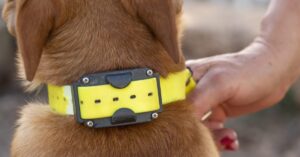
Dog care Shock collars are often used in dog training for behavior correction, but it’s essential to use them responsibly and humanely.
- Here is a general guideline for using a dog care shock collar
- 1.General Guidelines for Using a dog care Shock Collar
- 2. Using the dog care shock collar
- 3.Important Considerations
- What are some of the main concerns with using dog care shock collar for dog training?
- 1.Animal Welfare Concerns:
- 2.Effectiveness Concerns
- 3.Ethical Considerations
- What are your thoughts on the long-term effects of using dog care shock collar on a dog’s behavior and well-being?
Here is a general guideline for using a dog care shock collar
1.General Guidelines for Using a dog care Shock Collar
Read the Manual: Always start by thoroughly reading the manufacturer’s manual that comes with the dog care shock collars. Each brand may have specific instructions and safety guidelines.
Proper Fit: Ensure the collar fits snugly but not too tight. You should be able to fit two fingers between the collar and your dog’s neck.
Initial Testing: Test the shock collar on yourself at the lowest setting before using it on your dog to understand its effect.

Start with the Lowest Setting: Always start with the lowest intensity setting and gradually increase only if necessary.
Training Sessions: Use the shock collar during training sessions only and not for extended periods. A typical session should last no more than 15-20 minutes.
Positive Reinforcement: Combine the use of the shock collar with positive reinforcement techniques, such as treats and praise, to encourage desired behavior.
Supervision: Always supervise your dog while using the shock collar to ensure their safety.
Behavioral Issues: Shock collars should not be used to address aggression, fear, or anxiety issues. These require professional training and possibly the assistance of a behaviorist.
Regular Inspection: Regularly check your dog’s neck for any signs of irritation or sores and inspect the collar for any damage.
Consult Professionals: If you’re unsure about using a dog care shock collar, consult with a professional dog trainer or a veterinarian.
2. Using the dog care shock collar
Introduction: Allow your dog to get used to wearing the collar without activating it for the first few days.
Association: Create a positive association with the collar by using treats and praise when putting it on.
Basic Commands: Start with basic commands such as “sit,” “stay,” and “come” while using the collar at the lowest setting.

Correction Timing: Administer the correction at the exact moment the undesirable behavior occurs. Timing is crucial for the dog to make the correct association.
Consistency: Be consistent with your commands and corrections. Inconsistency can confuse your dog.
Gradual Reduction: Gradually reduce the use of the dog care shock collar as your dog learns and adheres to the desired behaviors.
3.Important Considerations
Not for Puppies: Do not use dog care shock collar on puppies younger than 6 months.
Health Conditions: Avoid using shock collars on dogs with health issues, particularly heart problems.
Environment: Ensure the environment is safe and controlled when using a shock collar to prevent any accidents.
For specific instructions related to your shock collar model, please refer to the manual provided by the manufacturer. If you need help with a particular brand or model, feel free to share more details, and I can offer more tailored advice.
What are some of the main concerns with using dog care shock collar for dog training?
There are several key concerns that have been raised about the use of shock collars for dog training:
1.Animal Welfare Concerns:
Shock collars can cause pain, distress, and fear in dogs, which goes against principles of humane and ethical animal handling.
The use of pain or punishment-based methods can damage the dog-owner relationship and undermine the dog’s trust.
There is risk of physical injuries like burns or tissue damage from improper fit or accidental over-stimulation.
2.Effectiveness Concerns
Shock collars may suppress unwanted behaviors temporarily, but don’t address the underlying causes or teach the dog alternative, desired behaviors.
Reliance on dog shock collars can inhibit a dog’s natural learning and behavioral development.
Dogs may learn to associate the shock with unrelated stimuli, leading to unintended behavioral problems.
3.Ethical Considerations
Many animal welfare organizations consider dog care shock collar to be inhumane and unethical tools that should be avoided in favor of positive reinforcement.
There are concerns that dog care shock collar demonstrate a lack of understanding of dog behavior and training principles.
The use of dog shock collars raises questions about the balance of power and consent in the human-dog relationship.
Overall, the scientific evidence and ethical arguments suggest that more humane, positive reinforcement-based training methods are preferable for the wellbeing of dogs. I’d be happy to provide some recommendations for alternative training resources if you’re interested.
What are your thoughts on the long-term effects of using dog care shock collar on a dog’s behavior and well-being?
The long-term effects of using dog shock collars on a dog’s behavior and well-being are a significant concern for animal welfare experts and trainers. Here are some of the potential negative impacts that have been identified through research and experience:

Increased Anxiety and Fear: Repeated use of shock collars can cause dogs to become fearful, anxious, and stressed, even in non-training contexts. This can lead to broader behavioral issues like avoidance, aggression, or lack of socialization.
Compromised Trust and Bonding: The use of punishment-based methods like shock collars can damage the trusting, cooperative relationship between a dog and their owner. This undermines the dog’s ability to learn and thrive.
Learned Helplessness: Dogs may eventually learn that they have no control over the shocks and stop attempting to avoid or escape them, leading to a state of learned helplessness.
Suppressed Natural Behaviors: Shock collars can prevent dogs from exhibiting their normal, healthy behaviors, such as barking, digging, or exploring their environment. This can have detrimental effects on their physical and psychological wellbeing.
Increased Risk of Aggression: In some cases, the pain and fear associated with shock collars has been linked to increased aggression, as the dog tries to defend itself.
Long-Term Behavioral Issues: The use of dog shock collars during critical developmental stages can lead to persistent behavioral problems that are difficult to remediate later in life.
Overall, the scientific consensus is that the potential for long-term harm to a dog’s welfare outweighs any supposed training benefits of shock collars. Most animal behavior experts recommend positive reinforcement-based methods as a safer, more effective, and more humane approach to dog training.
Capturepet thank you for reading.
